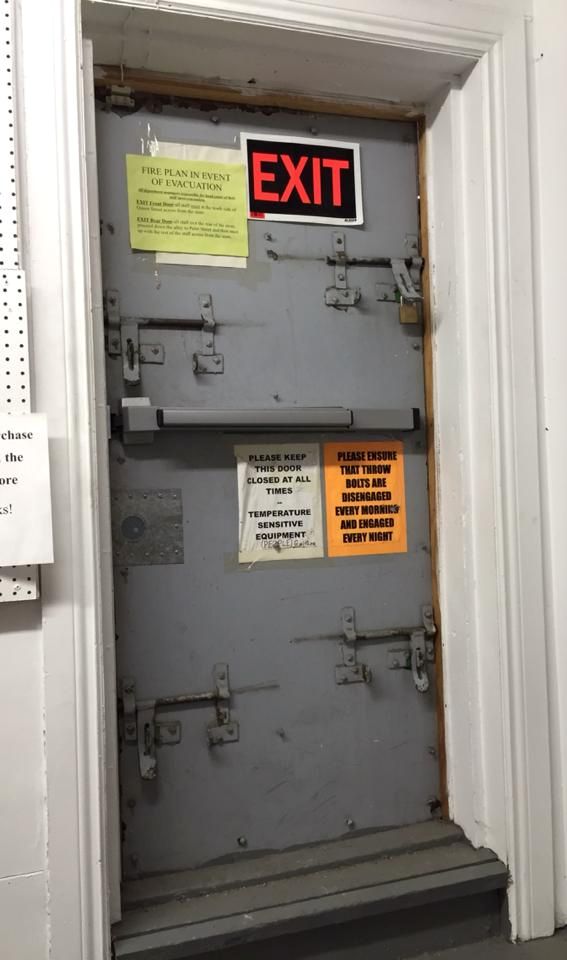This Wordless Wednesday photo from Dan Curia of the Durham Fire Department is posted with permission from Buster Cooper of the Conway Fire Department, who shared it on Truck Floor Training’s Facebook page.
What I want to know is…why do some people think it’s ok to use these locks after-hours, when the building is unoccupied? I don’t see anything in the codes to support that, but it seems to be a common belief. Am I missing something?
You need to login or register to bookmark/favorite this content.






At least I know there’s someplace to go for a zombie apocalypse.
WOW!!!
Must be a rough area of town.
Guess an AHJ would let them pass because an employee still in the space after business hours would have the special knowledge necessary to get out of the space as well as knowing exactly where the closest exit would be.
How is this any different than a double keyed deadbolt with a sign stating that the door must remain unlocked when the business is occupied???
Hi Dan –
The codes limit the double-cylinder deadbolts to the main entrance in certain occupancy types, because the thought is that you can’t operate the facility without unlocking that door. Many of the crazy multiple-lock doors I post photos of are not the main entrance and could easily be left locked while the building is occupied.
– Lori
Steel door $600
4 giant bolts $100
Panic Device $400
…
Crowbar $20
Spending $1000+ to protect an opening that will be opened in 30 seconds with a crowbar because of the wood frame? Priceless. May as well just put a piece of plywood there.
At least they didn’t bother with a closer! Or maybe it’s mounted regular arm?
Looks like Hillary Clinton’s server room door!
NFPA-101, 2012 7.2.1.1.3.2 Occupied Building Section.
Where means of egress doors are locked in a building that is not considered occupied, occupants shall not be beyond their control in buildings or building spaces, except for lockups in accordance with 22.4.5 and 23.4.5 detention and correctional occupancies, and health care occupancies.
NFPA-101, 7.2.1.5.5.1 Exterior doors assemblies shall be permitted to have key-operated locks from the egress side, providing that all the following criteria are met: Read (1)-(4).
I looked into the New Assembly Occupancy to see what it says about locked egress doors. NFPA-101, 12.2.2.2.4 Reads similar to IBC
Then Chapter 39 Existing Business: 39.2.2.2.2* Locks complying with 7.2.1.5.5 shall be permitted only on principal entrance / exit doors.
IBC 2009, 1008.1.8.3 reads differently than NFPA-101 but has the same results.
The difference is Occupied and Unoccupied. People(mostly employees)in the Unoccupied building should have a general knowledge of the building and how to exit in case of emergency. When occupied, the general public does not have this general knowledge of all exits.
I hope this helps.
Hi Chuck –
The sections on key-operated locks are typically applied to a door with a double-cylinder deadbolt, and they are limited to the main entrance in the occupancies where they are allowed, with a requirement for signage, etc. I don’t think the intent of the code was to allow a bunch of padlocked slide bolts, but maybe the code needs to be tweaked a bit. I’ll put it on my list.
– Lori
This door can be argued as being compliant when unoccupied. It is the AHJ’s job to discern the code and to cite something that is beyond or unreasonable to the code as he read it. My guess is that the AHJ / municipal inspector, hasn’t had eyes on this door for years.
That’s quite a first step into the opening.
in certain circumstances, there is a difference in what you can do when the space is occupied vs. when unoccupied. I don’t know how far that extends, or what the official regulations say, just my experience with AHJs.
This is in NFPA 1 2006 and earlier:::
14.5.2.1 Doors shall be arranged to be opened readily from the egress side whenever the building is occupied. [101:7.2.1.5.1]
The NFPA 101 states: from 2006 and earlier:
7.2.1.1.3* For the purposes of Section 7.2, a building shall be considered to be occupied at any time it is open for general occupancy, at any time it is open to the public, or at any other time it is occupied by more than 10 persons.
So in the old days some inspectors did not consider the building occupied when there were no people in it, or ten or less. So alternative locking methods were allowed.
Interesting…I hope this perspective changes over time.
I’ve seen this at the back doors at local “Stater Bros. Markets” in my area. They have slide bolts on the latching side and they have always been padlocked in the unlocked position when I have looked but I figured it was a questionable method.
I’m pretty sure that threshold is NOT ADA compliant.
I think you’re right! 🙂